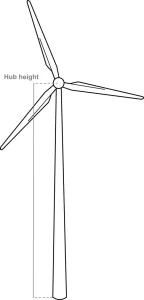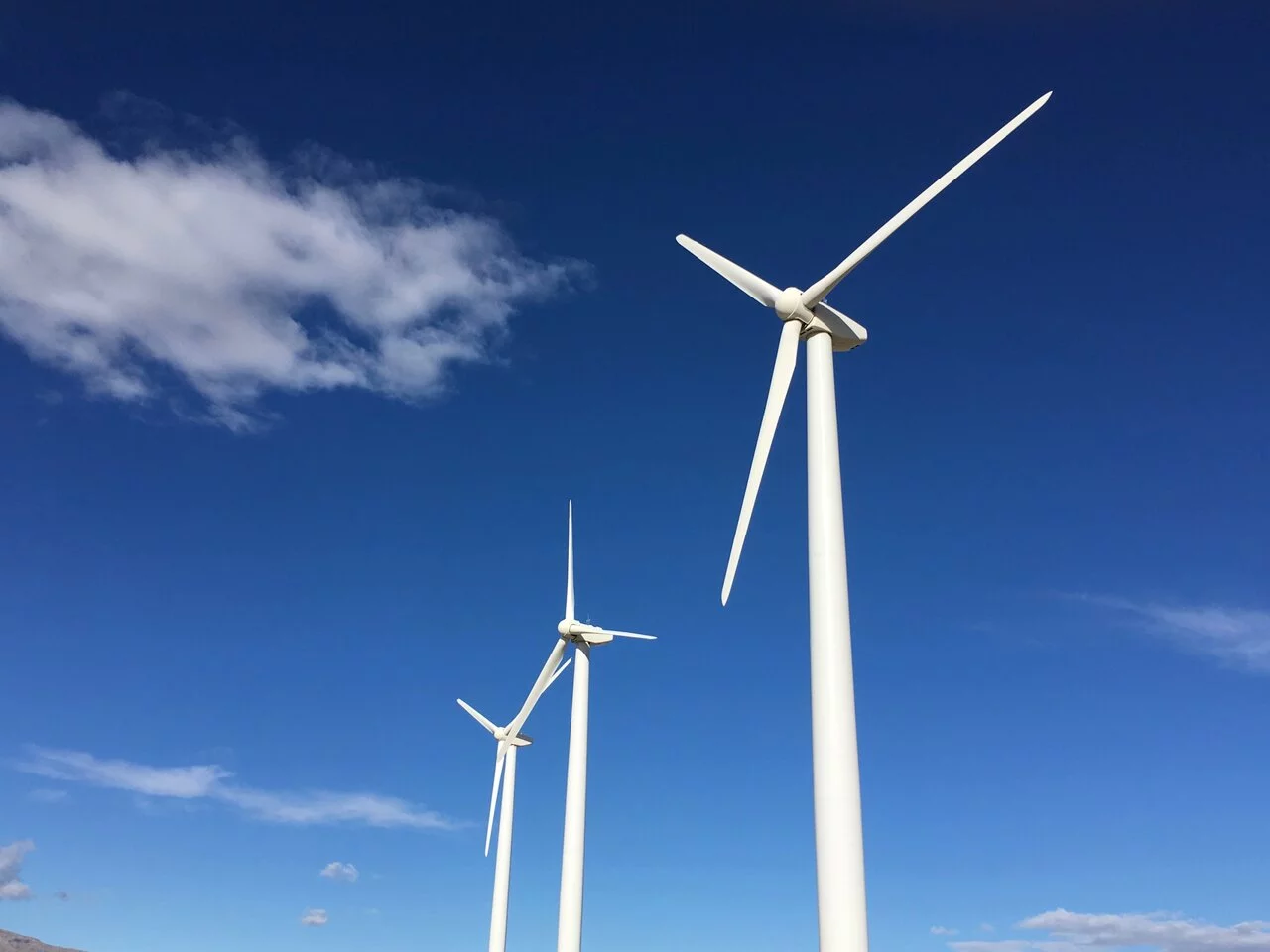Wind turbines generate electricity by capturing the kinetic energy of the wind. The amount of generated electricity depends on the size of the blades and the wind speed. But how much electricity does a wind turbine actually generate?
A wind turbine generates about 1.64 megawatts (MW). This is an average calculated from the number of turbines in the US wind turbine database (USWTDB) and its total rated capacity. However, the number assumes the turbines are working at full capacity, which is not the case.
In reality, wind turbines usually work with a 30-40% capacity, which means that an average wind turbine in the U.S. generates 0.49-0.66 MW. If we calculate the monthly electricity generation, it would be equivalent to about 355-473 MWh per month.
The average American home in 2019 consumed 877 kWh per month (Source). Therefore, a wind turbine would be able to generate electricity for 404-539 U.S. homes.
If we only consider newly installed wind turbines, the average capacity is a lot higher. According to the Wind Technologies 2018 Market Report, the average capacity of newly installed wind turbines in the U.S. is 2.43 MW.
What are the world’s largest and tallest wind turbines?
GE’s Haliade-X is an offshore wind turbine that stands at a height of 260 meters (853 feet), has 107 meter-long blades (351 feet) with a diameter of 220 meters (722 feet), and can generate 12-14 MW of power.
Siemens Gamesa recently announced SG 14-222 DD, an offshore wind turbine designed to produce 14 MW, and will begin its serial production in 2024. Its rotor diameter is 222 meters (728 feet), and its blade length is 108 meters (354 feet).
Vestas announced the V236-15.0 MW in February 2021. As the name implies, the wind turbine will have a rotor diameter of 236 meters (774 feet) and will be able to generate 15 MW of power when it is commercially produced in 2024.
| Manufacturer | Model | Hub Height | Rotor Diameter | Blade Length | Power Rating (MW) | Production Year |
| General Electric | Haliade-X | Up to 150 m (492 ft) | 220 m (722 ft) | 107 m (351 ft) | 12-14 | 2021 |
| Siemens Gamesa | 14-222 DD | Site-Specific | 222 m (728 ft) | 108 m (354 ft) | 14 | 2024 |
| Vestas | V236-15.0 MW | Site-Specific | 236 m (774 ft) | 115.5 m (379 ft) | 15 | 2024 |
How tall are wind turbines?
The average height of wind turbines in the U.S. is about 80 meters (262 feet). The hub height is a term used to describe the distance from the platform to the rotor. According to data from the USGS, wind turbine hub heights have a range of 19-131 meters (62-430 feet) and an average of 80 meters or 262 feet.

Since the hub height does not include the blades’ length, the height of a wind turbine is actually greater than usually reported. In fact, the total height of a wind turbine is equal to the sum of the two (hub height and rotor blade length).
Rotor blades add to the height of a turbine since the hub height does not account for their length. Rotor diameters have also increased from a maximum of 40 meters (131 feet) in 1990 to 220 meters (722 feet) in 2021.
Historically speaking, the average total height of wind turbines has been rapidly increasing due to increased power generation requirements. The maximum height was only 50 meters (164 feet) in 1990 but has increased to about 260 meters (853 feet) in 2021 (Source).
Why do wind turbines have 3 blades?
Wind turbines today either have 2 or 3 blades with 3 blades being more common.
The main reason why most wind turbines have 3 blades is efficiency. As the number of blades increases from 1 to 2 and 2 to 3, the efficiency increases by 6% and 3%, respectively. Increasing the number of blades to 4 only slightly improves efficiency and cannot be justified when looking at the extra manufacturing cost.
Another reason for having 3 blades on a turbine is aesthetics. Wind turbines that have 1 or 2 blades are faster and appear to have jerky motions. The relatively slower 3-bladed designs are more aesthetically pleasing and appear to run more smoothly.
Why are wind turbines installed close to each other?
Wind turbines can be installed both onshore and offshore. Installing wind turbines close to each other as part of a wind farm or wind park is often the best choice. This is usually because of the suitability of the selected location and easier maintenance operations and connections to the grid. Every 2-3 wind turbines are usually connected to the same transformer, which reduces the collection system’s cost and the losses in the electricity lines.
On the other hand, there needs to be a minimum distance between wind turbines. Installing wind turbines very close to each other will reduce their power production and increase maintenance costs. The blades of a turbine create a field of turbulence that affects the power production of nearby turbines.
What is the capacity factor of a wind turbine?
The capacity factor is a ratio of the actual electricity output of a system to its maximum possible output. For a wind turbine, the capacity factor describes the gap between the actual and ideal electricity output of the wind turbine over a whole year.
The capacity factor of a wind turbine is usually 20-40%. In recent years, the capacity factors of wind farms have been consistently increasing and have reached more than 40%. In the U.S., for example, the average capacity factor for wind projects built between 2014 and 2017 was 41.9%. This is considerably higher than the average of 30.8% for projects built during the period between 2004 and 2011 (Source).
What affects the capacity factor of a wind turbine?
A wind turbine’s capacity factor is affected by its size, location, hub height, type, in addition to wind speed and probability distribution. The monthly capacity factor of a wind turbine also varies considerably throughout the year, depending on the available wind.
Do wind turbines use fossil fuels?
No, wind turbines do not use fossil fuels. They work by simply using the available wind to generate power. Like almost every other piece of modern equipment, wind turbines require energy for their manufacture.
This is usually accounted for when conducting a life-cycle analysis (LCA) of a system. The number of resources, including fossil fuels that go into the manufacture, transportation, and disposal of a wind turbine, can be estimated using this method.
Are wind turbines recyclable?
Wind turbines are typically made of four main parts: a foundation, a tower, a nacelle (housing for generator and other equipment), and 3 blades. All components of a wind turbine are recyclable except the rotating blades.
The recycling of blades remains problematic because of the composite material used in their manufacture. There are currently no mature recycling channels for composite material. Although several processes have been developed to recover material from wind turbine blades, they are not yet as cost-effective as conventional landfilling.
As for the remaining parts of a wind turbine, they can be easily recycled. The material used to fabricate the nacelle (steel, copper), tower (concrete or steel), and foundation (concrete) are much easier to recycle.
Do wind turbines use oil?
No, wind turbines do not directly use oil. However, oil is used in the manufacturing process and the transportation of the different wind turbine components.
Also, a wind turbine needs lubrication, and gear oil made from synthetic-base oils accounts for 70% of the lubricants used. As the wind turbine installed capacity continues to grow worldwide, so does the required volume of gear oil.
How much oil do wind turbines use?
Wind turbines have a lifetime of 20-25 years and need their gear oils changed every 1-2 years. The required gear oil for a wind turbine can be as much as 600 liters (159 US gallons).
Machinery Lubrication reports that most oil changes are currently done every 8-12 months and that some can last as long as 16 months without an oil change.
Some advanced synthetic gear oils can last up to 10 years which means that turbines would only need one oil change throughout their lifetimes.
What are the pros and cons of wind turbines?
Wind turbines are a renewable and clean energy source, unlike power generation from fossil fuels. This means that there are no direct carbon emissions associated with power generation from wind turbines. Since the source of energy is wind, it is considered a renewable energy source. Wind turbines do not cost a lot to operate as well. Other than the annual oil change or maintenance check, wind turbines do not consume any resources. Wind turbines are also a local source of energy which means remote areas can become self-sufficient and independent.
On the other hand, wind turbines utilize an intermittent energy source, which results in a low capacity factor (20-40%). Some people also do not find wind turbines aesthetically pleasing, especially in places where there aren’t many human-made structures, such as the countryside. Wind turbines also generate a swishing sound as the blades rotate and move through the air. Although the sound is not very loud (40-55 decibels at a distance of 300 meters), wind turbines are still considered a source of noise pollution. Finally, good wind sites are located far away from cities where electricity is needed the most.
| Pros | Cons |
| Renewable | Low capacity factor |
| Clean | Noise pollution |
| Low operation cost | Visual pollution |
| Local | Location |
What are wind turbines used for?
Wind turbines are used to generate electricity cleanly and sustainably. By tapping into the wind’s energy, wind turbines allow kinetic energy to be converted into electrical energy. Wind is the movement of air resulting from pressure differences in the Earth’s atmosphere at different locations. Air moves from higher to lower pressure. These pressure differences are in turn a result of the sun heating the surface of the Earth and its atmosphere differently. Therefore, the sun is the origin of the wind energy utilized by wind turbines.
Who makes wind turbines?
A lot of international companies, mainly based in Europe and Asia, manufacture wind turbines. Based on their total installed wind turbine capacity and the number of projects, the following are the world’s top wind turbine manufacturers:
| Manufacturer | Headquarters | Total Installed Capacity (GW) |
| Siemens Gamesa Renewable Energy S.A. | Zamudio, Spain | 107 |
| Vestas Wind Systems A/S | Aarhus, Denmark | 132 |
| GE Renewable Energy | Paris, France | 62 |
| Enercon GmbH | Aurich, Germany | 50 |
| Nordex SE | Rostock, Germany | 32 |
| Xinjiang Goldwind Science & Technology Co. | Beijing, China | 60 |
| Sinovel Wind Group Company | Beijing, China | 16.5 |
| Suzlon Energy Limited | Pune, India | 12.8 |
| MHI Vestas Offshore Wind | Aarhus, Denmark | 3.2 |

